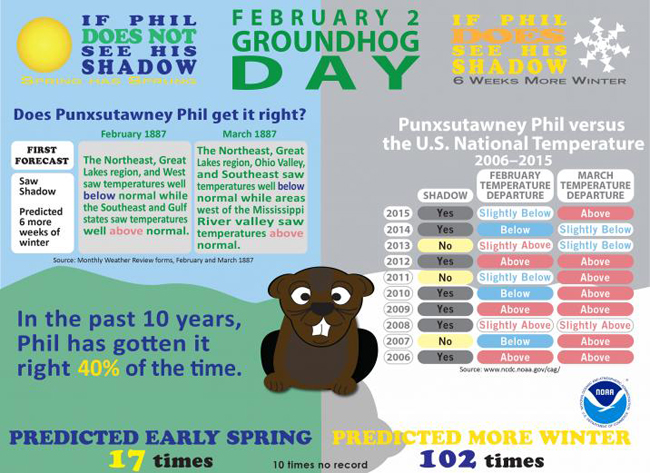NYSG's Social Media Review: Early February 2016
By Paul F on Feb 5, 2016 at 1:12 PM
We're making our way through winter and another wrap-up of the coastal science stories making headlines at the National Oceanic and Atmospheric Administration (NOAA) and its line offices (including Sea Grant) ...

Although he may not be the most accurate of weather predictors, Punxsutawney Phil is a fave go-to character every February on Groundhog Day. Even though he’s been forecasting since 1887, Phil’s track record for the entire country isn’t perfect. To determine just how accurate he is, NOAA, Sea Grant's federal organization, has compared U.S. national temperatures with Phil’s forecasts. On average, Phil has gotten it right 40% of the time over the past 10 years: http://ow.ly/XZIMy.
In News from NOAA's New York Sea Grant ...
(1) There are just a few Sea Grant student fellowship opportunities remaining for this year - with deadlines ranging from early to mid-February. Keep tabs on our fellowships and requests for proposals at www.nyseagrant.org/proposals or via our RSS news feed alert feature, www.nyseagrant.org/rss/fundingopportunities.
(2) On February 1st, Our traveling “Great Lakes Shipwrecks” exhibit began a two-and-a-half month residency at the Tom Ridge Environmental Center in Erie, Pennsylvania: http://ow.ly/XQJSE.
(3) Register for the February 20th Young Boater Safety Training at the 2016 Central New York Boat Show in Syracuse, NY: http://ow.ly/XX1gW.
(4) Videos from from November 2015's Nature-Based Shoreline Practices Workshop have now been added to the resources found at www.nyseagrant.org/naturebasedshorelines.
(5) Attendees at several recent NYC workshops served as beta testers for "Visionmaker.NYC," a Web application enabling people to develop and share their own client-resilient designs for Jamaica Bay. These designs are based on rapid and realistic model assessments of carbon, water, biodiversity and population. Learn more about the Jamaica Bay Science and Resilience Institute, which New York Sea Grant is partner, at http://www.srijb.org.
(6) For those who couldn't be a part of our five-part Watercraft Inspection Webinar series in Fall 2015, you can stream each discussion and download presentations at www.nyseagrant.org/watercraftinspection.
Top 10 Trending News Stories from NOAA ...
(1) WEATHER >>> Putting the January 22–24, 2016 snowstorm in historical context: http://ow.ly/XZLoV. And check out weather in your neck of the woods anytime at http://www.weather.gov or http://www.weather.gov/socialmedia.
(2) KID-FRIENDLY SCIENCE >>> Tomorrow (February 6th) is NOAA's Open House at its Science Center in Silver Spring, Maryland: http://www.noaa.gov/openhouse. ?#NOAAOpenHouse?
(3) CLIMATE >>> A warming ocean may bring major changes for U.S. Northeast fish species: http://go.usa.gov/cm8XY.
(4) WINTER WEATHER >>> The frequency of extreme snowstorms in the eastern two-thirds of the United States has increased over the past century despite overall warming of Earth’s surface temperature. Find out why and learn more about climate change and extreme snow in the U.S.: http://1.usa.gov/1K7et7r.
With so much of the country under winter watches and warnings and advisories, here are 5 things you should know: http://weather.gov/winter.
(5) CLIMATE >>> Everything you need to know about the El Niño-Southern Oscillation (ENSO) is at http://climate.gov/enso.
(6) WATER QUALITY >>> Marine debris is not only unsightly, but it also costs you money. For example, one NOAA study shows marine debris costs residents in California millions of dollars: http://ow.ly/XZNfW. Find out what you can do at http://marinedebris.noaa.gov.
(7) DROUGHT >>> According to NOAA's February 2, 2016 U.S. Drought Monitor (http://1.usa.gov/1nJLZqf), moderate to exceptional drought covers 15.5% of the contiguous United States for a second week. The worst drought categories (extreme to exceptional drought) also held steady at 4.6%. Courtesy of www.drought.gov ?#DroughtMonitor?
(8) U.S. CLIMATE >>> In 2015, the contiguous United States experienced its 2nd warmest year and warmest December on record. Records date back to 1895. In total, the nation experienced 10 weather and climate disaster events each with losses exceeding $1 billion. These events included a drought, 2 floods, 5 severe storms, a wildfire event and a winter storm. Tragically, these events resulted in the deaths of 155 people. Learn more about these disasters (http://1.usa.gov/1lWhhVP) and check out NOAA's 2015 Annual U.S. Climate Report, http://1.usa.gov/1PKdppg ?#StateOfClimate?
(9) GLOBAL CLIMATE >>> 2015 also set a new global temperature record, moving ahead of the record set just last year by 0.29°F—the largest margin by which one year has ever beaten another since official records began in 1880. Learn why it's no surprise (+ see/download NOAA's animated GIF) http://bit.ly/2015globalrecord. Also, NASA's press release: http://ow.ly/XZOMi.
(10) GLOBAL CLIMATE >>> During December 2015, the average temperature across global land and ocean surfaces was 2.00°F (1.11°C) above the 20th century average. This was the highest departure from average for December in the 1880-2015 record, surpassing the previous record of 2014 by 0.52°F (0.29°C). The December temperature departure from average was also the highest departure among all months in the historical record and the first time a monthly departure has reached 2°F.
Overall, the globally averaged temperature over land and ocean surfaces for 2015 was the highest among all years since record keeping began in 1880. This is also the largest margin by which the annual global temperature has been broken. See more in the 2015 Global Climate Report: http://1.usa.gov/1Oph4Gs.
---
On www.nyseagrant.org ...
- Our "Trending Topics," such as climate change and green tips for coastal living, via a section on our homepage, www.nyseagrant.org.
- For the latest news from NYSG, check out our 'Currents' section, www.nyseagrant.org/currents, as well as our 'by-topic' archives, www.nyseagrant.org/currentsarchive.
- To keep tabs on all of NYSG's coastal science news, follow us on Facebook (www.facebook.com/nyseagrant), Twitter (www.twitter.com/nyseagrant) and YouTube (www.youtube.com/nyseagrant); Subscribe to our free news feeds (click the orange & white icon in the "Follow Us" navigation bar at www.nyseagrant.org); Sign up for our e-list in a few quick clicks at www.nyseagrant.org/nycoastlines. Our flagship publication, NY Coastlines / Currents, is published 1-2 times a year.